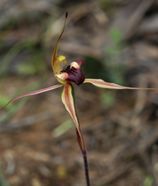Spider Orchids: Anglesea is very fortunate to have a number of Spider Orchids growing in the district, ranging in size from the Caladenia parva Small Spider Orchid, mostly shorter than 15 cm, to the Caladenia venusta Large White Spider Orchid that grows to 60 cm in height.
They are called Spider Orchids because of their long, filamentous sepals and petals that could be said to resemble spiders’ legs. They all have a single hairy basal leaf, and a hairy stem.
September and October are great months to look for Spider Orchids, which could be growing in various habitats in the district. We have ten different species, and a number of recognized hybrids. However, two of these species are exceptionally rare, and are therefore unlikely to be seen; these are Caladenia capillata Daddy Long Legs and Caladenia valida Robust Spider Orchid, listed as endangered in Victoria. Three more of our Spider Orchids, Caladenia australis Southern Spider Orchid, Caladenia oenochila Red-lipped Spider Orchid and the Caladenia venusta Large White Spider Orchid are listed on the Victorian Threatened Species List.
Generally, the different species are easy to distinguish. You will find their photographs and descriptions in Orchids of the Anglesea District available from Angair or local bookshops.
However, there are two species that can sometimes be confused – the Red-lipped Spider orchid and the Southern Spider Orchid. They are very similar in size and colour, but if you look closely at the tips of the sepals on both species, you will notice that the Red-lipped Spider Orchid has dark glandular hairy tips, whereas those of the Southern Spider Orchid have dark red flattened clubs to 12 mm long.

Red-lipped Spider Orchid

Southern Spider Orchid
Another of our Spider Orchids that has clubs at the end of the sepals is Caladenia clavigera Plain Lip Spider Orchid. However, the clubs in this species are short and beady.

Plain Lip Spider Orchid
Spider Orchids reproduce solely from seed, with plants producing a replacement tuber each season. They are pollinated by male flower wasps, which have been attracted by scents mimicking the female wasp. They are indeed fascinating flowers.
Of course, there are many other orchid species to see in the field in spring, and the onset of our Sun Orchids will surely tempt orchid lovers to venture out in the next few months. We hope you can find time to enjoy them.
Margaret MacDonald